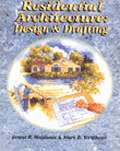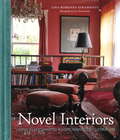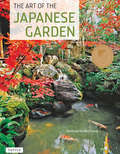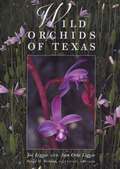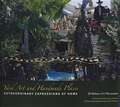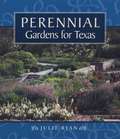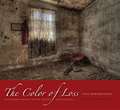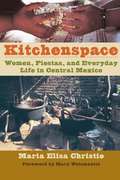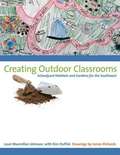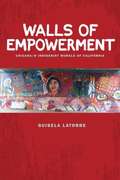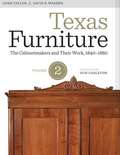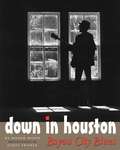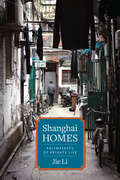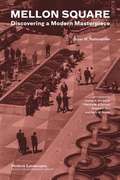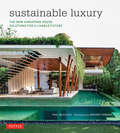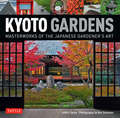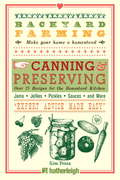- Table View
- List View
Residential Architecture: Design and Drafting
by Ernest R. Weidhaas Mark D. WeidhaasThis comprehensive text provides a complete overview for beginning and intemediate students. With equal emphasis on design and drafting, the book leads students through the design of a contemporary home from preliminary program to finished rendering, with plans included in relevant chapters. Applied academics are integrated throughout the text, applying math, social studies, science, and communication to the field of architectural drafting. Career profiles give students the perspective they need to plan their own careers. Beyond the basics, the text also explores such contemporary issues as environmental sensitivity, accessibility for the physically challenged, alternate energy sources, radon control, earthquake protection, and construction administration, to name a few. A complete set of plans exposes students to commercial construction. Features on computers and the Internet prepare students for the technological challenges they will encounter in the workforce. An ideal introduction to architectural drafting and design!
Novel Interiors
by Ivan Terestchenko Lisa Borgnes GiramontiFor those who have ever lost themselves in the stylish worlds of novels like Sense and Sensibility, The Age of Innocence, Wuthering Heights, The Picture of Dorian Gray and countless others, this design book embraces the fantasy of time and place, showing you how to bring some of those elements into your own home.Lisa Giramonti inspires a new approach to decorating: by teaching us through the lens of worlds we may already know and love. With gorgeous photographs by World of Interiors photographer Ivan Terestchenko, aspirational quotes, and tailored reading lists, Novel Interiors reveals the essence and details of interiors mentioned in great literary works. This is a stunning, photo-driven book that shares enchanting and timeless ways to live more elegantly.
Marijuana Success Indoors
by Ed RosenthalMarijuana Success Indoors looks into the gardens of real people to see how they have combined gardening skill with technological savvy to produce quality buds. This large-format, 8.5 x 11 inch book focuses on homegrowing cultivation issues and solutions, including working in small spaces, the use of hydroponics versus planting mix gardens, lighting, and supplementing with CO2. A great companion to information found in grow guides Marijuana Success Indoors shows what types of problems are encountered in actual gardening situations, and how they are addressed to result in success.
The Art of the Japanese Garden
by David Young Michiko Young Tan Hong YewWinner of the 2006 American Horticultural Society Book Award! The Art of the Japanese Garden traces the development and blending of gardening traditions, as well as the inclusion of new features as gardening reached new heights of sophistication on Japanese soil. The book features a number of the most notable gardens in Japan, including graveled courtyards, early aristocratic gardens, esoteric and paradise gardens, Zen gardens, warrior gardens, tea gardens and stroll gardens.
The Home Owner's Manual
by Dan Ramsey Paul Kepple Jude Buffum The Fix-It ClubAt Last! A Beginner's Guide to Home Technology Water stains on your ceiling. Dents and cracks in your drywall. Radiators that hiss and gurgle all night long. It's enough to make you cry out, "Why doesn't my house come with an owner's manual?" And now--finally!--it does. Through step-by-step instructions and helpful schematic diagrams, The Home Owner's Manual explores hundreds of frequently asked questions: What's the best way to fix a leaky faucet? When should I have my chimney cleaned? How can I reset a circuit breaker without electrocuting myself? Whatever your concerns, you'll find the answers here--courtesy of licensed building contractor Dan Ramsey, who has taught the basics of renovation to thousands of homeowners.
Complete Do-it-Yourself Manual Newly Updated
by Editors Of Family HandymanThe leading manual for home improvements is getting an update to address current codes, latest materials, tools and technology.The bestselling, most comprehensive guide to home improvements has been revised and updated once again since it's revision in 2005. Over 10 million copies of READER'S DIGEST COMPLETE DO-IT-YOURSELF MANUAL have been sold since it's original publication in 1973. In 2005, the manual got bigger and better than ever, when The Family Handyman and Reader's Digest joined forces and completely revised, updated, rewrote, and redesigned this home improvement classic. Now in 2014, The Family Handyman has once again updated and revised this do-it-yourself classic to make it relevant to today's homeowners and DIYers.. Written in a style of text that addresses readers in a very accessible, conversational tone for easy, user-friendly assistance with every do-it-yourself task. All instructions and materials have been updated to address current codes (electrical, plumbing and building), and revised to indicate the very latest in materials, tools, and technology. Suitable for beginners and experts alike, this newly revised edition includes: * Over 3,000 photos and illustrations to make complex projects and repairs easy to understand * Twice as many storage projects that help home owners cut clutter * New building materials that yield great-looking, long-lasting results--and low maintenance! * New technology that lets homeowners save energy, add convenience or improve security. * New building codes that make homes safer, more energy-efficient and trouble-free. The book's tried-and-true instructions provide do-it-yourself solutions to a ton of problems that could cost a fortune if you had to hire a professional. This manual is a "must-have" reference guide for every home-owning man or woman.
Wild Orchids of Texas
by Joe Liggio Ann Orto LiggioFrom the East Texas swamps and forests to the Edwards Plateau canyons and the Trans-Pecos mountains, Texas hosts a surprising number of native orchids. Their exquisite beauty endears them to everyone from wildflower lovers to professional botanists and conservationists. This beautifully illustrated book presents all 54 wild orchids of Texas. The species descriptions that accompany Joe Liggio's lovely color photos discuss the plant's flowers, blooming season, pollinators, typical habitats, and range (also shown by map), including its distribution within and beyond Texas. The species are grouped by genus and also listed by color, county, and habitat for easy reference. In addition to the species accounts, the authors offer a general natural history of Texas orchids that discusses such topics as pollination and reproduction, special growing requirements, and threats to orchids from loss of habitats and careless collecting. They also describe the many orchid habitats in Texas and the species that grow in each. This wide variety of information, which has never before been collected in one volume for a general readership, makes this book the essential guide to Texas' wild orchids.
Yard Art and Handmade Places: Extraordinary Expressions of Home
by Jill Nokes Pat JasperRelatively few people in America build their own homes, but many yearn to make the places they live in more truly their own. Yard Art and Handmade Places profiles twenty homemakers who have used their yards and gardens to express their sense of individuality, to maintain connections to family and heritage, or even to create sacred spaces for personal and community refreshment and healing. Jill Nokes, an authority on native plants and ecological restoration, traveled across the state of Texas, seeking out residents who had transformed their yards and gardens into oases of art and exuberant personal expression. In this book, she presents their stories, told in their own words, about why they created these handmade places and what their yard art has come to mean to them and to their communities. Rather than viewing yard art as a curiosity or oddity, Nokes treats it as an integral part of home-making, revealing how these places become invested with deep personal or social meaning. Yard Art and Handmade Places celebrates the fact that, despite the proliferation of look-alike suburbs, places still exist where people with ordinary means and skills are shaping space with their own hands to create a personal expression that can be enjoyed by all.
Perennial Gardens for Texas
by Julie RyanA perennial garden is an ever-changing source of delight. Each season brings new colors and textures in flowers and foliage. As the years go by, perennial plantings mature and interweave into forms more beautiful and surprising than a season's growth of annuals can ever give. Best of all, a perennial garden can grow almost anywhere with plants suited to local soils, temperatures, and rainfall. This book is a complete guide to perennial gardening in Texas and similar regions of eastern New Mexico, Oklahoma, Arkansas, Louisiana, Mississippi, Alabama, Georgia, Florida, and the Carolinas. In Part One, Julie Ryan offers a historical sketch of cottage gardens and perennial borders, with a sampler of some of their modern variations. In Part Two, she defines the major ecological regions of Texas and, with words and color photographs, takes you on a tour of lovely public and private gardens in each region. You'll find all the "how to" information for creating your own garden in Part Three. Ms. Ryan describes and pictures over 300 flowering perennials, bulbs, foliage plants, and old roses suitable for Texas gardens, with lists of companion annuals, vines, shrubs, and small trees. Accompanying charts provide quick reference to each plant's preferred regions and cultivation requirements. In addition, Ms. Ryan discusses how to design a garden and select plants, prepare the beds, and deal with garden pests. She concludes with substantial lists of resources, including mail-order suppliers of perennials, bulbs, and old roses.
The Color of Loss
by Dan BurkholderThe devastation of New Orleans after Hurricane Katrina has been imprinted in our collective visual memory by thousands of images in the media and books of dramatic photographs by Robert Polidori, Larry Towell, Chris Jordan, Debbie Fleming Caffrey, and others. New Orleanians want the world to see and respond to the destruction of their city and the suffering of its people-and yet so many images of so much destruction threaten a visual and emotional overload that would tempt us to avert our eyes and become numb. In The Color of Loss, Dan Burkholder presents a powerful new way of seeing the ravaged homes, churches, schools, and businesses of New Orleans. Using an innovative digital photographic technology called high dynamic range (HDR) imaging, in which multiple exposures are artistically blended to bring out details in the shadows and highlights that would be hidden in conventional photographs, he creates images that are almost like paintings in their richness of color and profusion of detail. Far more intense and poetic than purely documentary photographs, Burkholder's images lure viewers to linger over the artifacts of people's lives-a child's red wagon abandoned in a mud-caked room, a molding picture of Jesus-to fully understand the havoc thrust upon the people of New Orleans. In the deserted, sinisterly beautiful rooms of The Color of Loss, we see how much of the splendor and texture of New Orleans washed away in the flood. This is the hidden truth of Katrina that Dan Burkholder has revealed.
Kitchenspace
by Maria Elisa ChristieThroughout the world, the kitchen is the heart of family and community life. Yet, while everyone has a story to tell about their grandmother's kitchen, the myriad activities that go on in this usually female world are often devalued, and little scholarly attention has been paid to this crucial space in which family, gender, and community relations are forged and maintained. To give the kitchen the prominence and respect it merits, Maria Elisa Christie here offers a pioneering ethnography of kitchenspace in three central Mexican communities, Xochimilco, Ocotepec, and Tetecala. Christie coined the term "kitchenspace" to encompass both the inside kitchen area in which everyday meals for the family are made and the larger outside cooking area in which elaborate meals for community fiestas are prepared by many women working together. She explores how both kinds of meal preparation create bonds among family and community members. In particular, she shows how women's work in preparing food for fiestas gives women status in their communities and creates social networks of reciprocal obligation. In a culture rigidly stratified by gender, Christie concludes, kitchenspace gives women a source of power and a place in which to transmit the traditions and beliefs of older generations through quasi-sacramental food rites.
Creating Outdoor Classrooms
by Lauri Macmillan JohnsonSchoolyards have come a long way from the barren playgrounds that many people remember. Today's school campuses often feature gardens in which students can learn about native plants and wildlife, grow vegetables and fruit, explore cultural traditions, practice reading and math skills, and use their imaginations to create fun play spaces. And for a growing number of urban students, these schoolyard gardens offer the best, if not the only, opportunity to experience the natural world firsthand and enjoy its many benefits. This book is a practical, hands-on guide for creating a variety of learning environments in the arid Southwest. Filled with clear, easy-to-use information and illustrated with photographs, drawings, and plans, the book covers everything necessary to create schoolyard gardens:- An introduction to schoolyards as outdoor classrooms and several types of habitats, including art gardens, cultural history gardens, ecological gardens, literacy gardens, and vegetable gardens- Design theory, including a history of garden styles, and design principles and design elements- Beginning the design process, including identifying participants and writing a design program that sets out goals and requirements- Conducting site research and synthesizing design elements to arrive at a final design- Design essentials, including project funding and design features, maintenance, accessibility, safety, and project evaluation and revision- Wildlife ecology, including elements needed for survival such as food and shelter- Creating gardens for pollinators and other wildlife, including hummingbirds, butterflies, bees, moths, bats, and flies, as well as pest control- Lists of native plants for various kinds of habitats and nurseries that sell native plants, as well as books, web sites, and other resources for learning more about native plants and wildlifeThis guide will be essential for landscape architects, school personnel, parents, and students. Indeed, its principles can be used in designing schoolyard habitats across the country, while its information on gardening with native plants and wildlife will be useful to homeowners across the Southwest.
Walls of Empowerment
by Guisela LatorreExploring three major hubs of muralist activity in California, where indigenist imagery is prevalent, Walls of Empowerment celebrates an aesthetic that seeks to firmly establish Chicana/o sociopolitical identity in U. S. territory. Providing readers with a history and genealogy of key muralists' productions, Guisela Latorre also showcases new material and original research on works and artists never before examined in print. An art form often associated with male creative endeavors, muralism in fact reflects significant contributions by Chicana artists. Encompassing these and other aspects of contemporary dialogues, including the often tense relationship between graffiti and muralism, Walls of Empowerment is a comprehensive study that, unlike many previous endeavors, does not privilege non-public Latina/o art. In addition, Latorre introduces readers to the role of new media, including performance, sculpture, and digital technology, in shaping the muralist's "canvas. " Drawing on nearly a decade of fieldwork, this timely endeavor highlights the ways in which California's Mexican American communities have used images of indigenous peoples to raise awareness of the region's original citizens. Latorre also casts murals as a radical force for decolonization and liberation, and she provides a stirring description of the decades, particularly the late 1960s through 1980s, that saw California's rise as the epicenter of mural production. Blending the perspectives of art history and sociology with firsthand accounts drawn from artists' interviews, Walls of Empowerment represents a crucial turning point in the study of these iconographic artifacts.
Texas Furniture: The Cabinetmakers and Their Work, 1840-1880
by Lonn Taylor David B. WarrenThe art of furniture making flourished in Texas during the mid-nineteenth century. To document this rich heritage of locally made furniture, Miss Ima Hogg, the well-known philanthropist and collector of American decorative arts, enlisted Lonn Taylor and David B. Warren to research early Texas furniture and its makers. After more than a decade of investigation, they published Texas Furniture in 1975, and it quickly became the authoritative reference on this subject. An updated edition, Texas Furniture, Volume One, was issued in the spring of 2012. Texas Furniture, Volume Two presents over 150 additional pieces of furniture that were not included in Volume One, each superbly photographed in color and accompanied by detailed descriptions of the piece's maker, date, materials, measurements, history, and owner, as well as an analysis by the authors. Taylor and Warren have also written a new introduction for this volume, in which they amplify the story of early Texas furniture. In particular, they compare and contrast the two important traditions of cabinetmaking in Texas, Anglo-American and German, and identify previously unknown artisans. The authors also discuss nineteenth-century Texans' desire for refinement and gentility in furniture, non-commercial furniture making, and marquetry work. And they pay tribute to the twentieth-century collectors who first recognized the value of locally made Texas furniture and worked to preserve it. A checklist of Texas cabinetmakers, which contains biographical information on approximately nine hundred men who made furniture in Texas, completes the volume.
Art Against Dictatorship: Making and Exporting Arpilleras Under Pinochet
by Jacqueline AdamsArt can be a powerful avenue of resistance to oppressive governments. During the dictatorship of Augusto Pinochet in Chile, some of the country's least powerful citizens-impoverished women living in Santiago's shantytowns-spotlighted the government's failings and use of violence by creating and selling arpilleras, appliquéd pictures in cloth that portrayed the unemployment, poverty, and repression that they endured, their work to make ends meet, and their varied forms of protest. Smuggled out of Chile by human rights organizations, the arpilleras raised international awareness of the Pinochet regime's abuses while providing income for the arpillera makers and creating a network of solidarity between the people of Chile and sympathizers throughout the world. Using the Chilean arpilleras as a case study, this book explores how dissident art can be produced under dictatorship, when freedom of expression is absent and repression rife, and the consequences of its production for the resistance and for the artists. Taking a sociological approach based on interviews, participant observation, archival research, and analysis of a visual database, Jacqueline Adams examines the emergence of the arpilleras and then traces their journey from the workshops and homes in which they were made, to the human rights organizations that exported them, and on to sellers and buyers abroad, as well as in Chile. She then presents the perspectives of the arpillera makers and human rights organization staff, who discuss how the arpilleras strengthened the resistance and empowered the women who made them.
Houses Made of Wood and Light: The Life and Architecture of Hank Schubart
by Jane Hickie Michele DunkerleyAmerican architect Hank Schubart was regarded as a genius for finding the perfect site for a house and for integrating its design into the natural setting, so that his houses appear to be as native to the forest around them as the trees and rocks. Salt Spring Island, one of the Gulf Islands in British Columbia, Canada, offered him a place to create the kind of architecture that responded to its surroundings, and Schubart-designed homes populate the island. Built of wood and glass, suffused with light, and oriented to views, they display characteristic features: random-width cedar siding, exposed beams, rusticated stonework. Over time, Schubart's homes on Salt Spring Island came to be considered uniquely Gulf Islands homes. This inviting book offers the first introduction to the life and architecture of West Coast modernist Henry A. Schubart, Jr. (1916-1998). While still in his teens, Schubart persuaded Frank Lloyd Wright to accept him as a Taliesin Fellow, and his year's apprenticeship in the master's workshop taught him principles of designing in harmony with nature that he explored throughout the rest of his life. Michele Dunkerley traces Schubart's career from his early practice in San Francisco at the noted firm Wurster, Bernardi & Emmons, to his successful firm with Howard Friedman, to his most lasting professional achievements on Salt Spring Island, where he became the de facto community architect, designing more than 230 residential, commercial, educational, and religious projects. Drawing lessons from his mentors over his decades on the island, he forged an everyday architecture with his mastery of detail and inventiveness. In doing so, he helped define how the island could grow without losing its soul. Color photographs and site plans display Schubart's remarkable homes and other commissions.
Shanghai Homes: Palimpsests of Private Life
by Jie LiExploring three dimensions of private life territories, artifacts, and gossip Li re-creates the sounds, smells, look, and feel of home over a tumultuous century
Mellon Square
by Susan Rademacher Charles BirnbaumThe second volume in our Modern Landscapes series examines the evolution of Pittsburgh's first modern garden plaza. Completed in 1955 from a design by the acclaimed landscape design firm Simonds & Simonds and architects Mitchell & Ritchey, Mellon Square functioned as an urban oasis that provided downtown office workers a much-needed respite from the city's infamous smoke pollution. Now, more than six decades later, Mellon Square is undergoing a major restoration by Patricia O'Donnell of Heritage Landscapes that aims to restore this urban garden and help revitalize downtown Pittsburgh. Featuring new photography and archival material, Mellon Square is the only book to showcase the development of this iconic urban landscape.
Sustainable Luxury
by Paul McgillickSingapore is celebrated as one of the most livable cities in Asia, and Sustainable Luxury shows how the prosperous, forward-looking nation is pioneering innovative solutions for environmental, economic, social, and cultural issues faced the world over. Dr. Paul McGillick, the author of The Sustainable Asian House (Tuttle, 2013), presents twenty-seven recent residential projects created by Singapore's most talented architects to address the many complex and interconnected aspects of sustainability. Some of the homes featured here emphasize environmental needs, while others are concerned with preserving cultural traditions or supporting societal and interpersonal needs-such as extended family dwellings. Each residence, however, exhibits solutions developed from a holistic point of view. These homes typically embrace the tropical climate rather than fight it, and illustrate how smart manipulation of air flows, light, shade, water, and landscaping sustain higher levels of comfort without resorting to air-conditioning. In addition to profiling individual residences, Sustainable Luxury looks at the big picture, canvassing the most pressing issues-including changing demographics and lifestyles-and examining the available solutions. Anyone concerned with the future of our world will be fascinated by the houses presented here and the ways in which Singapore is leading the way in the development of residential architecture that is as luxurious as it is sustainable.
Kyoto Gardens
by Judith ClancyKyoto Gardens is a labor of love from master photographer Ben Simmons and Kyoto-based writer Judith Clancy. Simmons' photographs present a fresh and contemporary look at Kyoto's most important gardens. Their beauty is enhanced and humanized by gardeners tending the grounds using the tools of their art. Clancy's graceful text provides historic, aesthetic and cultural context to the gardens. Combining wonder and rigor, she describes how Kyoto's most beloved gardens remain faithful to their founders' creative spirit and conception. Journey to Kyoto's thirty gardens with just a turn of a page, or use the handy maps to plan your trip.
Alfie Gets in First
by Shirley HughesAlfie accidentally locks his mother and baby sister Annie Rose outside and can't reach the latch to let them in. Soon the whole neighborhood is involved in getting the door open.
Backyard Farming: Canning & Preserving
by Kim PezzaYour Backyard Farming Experience Begins Here!Make the most of your harvest with over 75 delicious canning recipes!At the end of a successful harvest, the backyard farmer will find themselves with an abundance of produce. Learning to preserve your harvest for use year-round is an essential craft. With the wide variety of uses for preserved produce, the homesteader will find Backyard Farming: Canning & Preserving the right guide to make certain your experience with home preserving is a success.Canning & Preserving takes you through every step of the most popular forms of canning, covering everything from hot water bath canning to the use of a pressure cooker, as you explore the full range of options for your preserved foods. From jams, jellies, and preserves, to pickling food and preparing savory sauces, find the perfect use for your preserved harvest.With Canning & Preserving, you will:* Explore tried-and-true food preservation methods* Learn to properly use the equipment needed to make the most of your harvest* Create flavorful syrups and juices, for use in a variety of healthy recipes* Enjoy delicious recipes year-round, using preserved foodsJoin the growing movement of homemakers and homesteaders looking to make a return to a healthier, happier way of life--direct to your kitchen from your own backyard. Canning & Preserving will show you how.Backyard Farming is a series of easy-to-use guides to help urban, suburban, and rural dwellers turn their homes into homesteads. Whether planning to grow food for the family or for sale at the local farmers market, Backyard Farming provides simple instruction and essential information in a convenient reference.From the Trade Paperback edition.
Go Organic, Level 6
by Saddleback Educational Publishing StaffThemes: Hi-Lo, nonfiction, full-color, differentiated instruction. Teach environmental studies and global warming in the inclusive classroom with these unique informational books. Available in two reading levels with identical front covers, so striving readers do not feel "singled out," each title methodically explains the tough problems faced by our planet plus solutions large and small. Features include: Reading level 3 books are Fountas-Pinnell level O, P, and Q; reading level 6 books are Fountas-Pinnell level W. Scientific terms are defined in context. Identical dramatic four-color covers (back cover band identifies books that are lower level). Teacher's Guides with reproducible activities allow students to work from either text. Glossary defines difficult terms. "Did You Know?" sections contain interesting facts. End-of-book "Facts & Figures" section summarizes critical information. The index takes students directly to topics of interest.
Art Deco
by Eric KnowlesAlthough most associated with the 1920s and 30s, Art Deco began in France prior to World War I. During the interwar years the style evolved and was adopted by an international elite set as the perfect expression of modern opulence and elegance in an age that gave birth to jazz, the Charleston, speakeasies, glamorous Hollywood films and engineering marvels such as skyscrapers. At the height of its popularity the Art Deco influence was seen in a wide variety of remarkable and innovative applications from decorative arts such as jewelry, metalwork, ceramics, and glass to massive scale applications in architecture, interior design, fashion, public works projects and consumer goods from automobiles to telephones to jukeboxes. This unique book is a collection of the most beautiful examples of Art Deco style from personal statements in jewelry to skyscrapers that defined city skylines, and examines the social and cultural climates of the 1920s and 30s which were perfectly aligned with the optimism and elegance of Art Deco. It traces the seminal influences in its evolution including the Ballets Russes, Cubism and the Bauhaus and explains why Art Deco style continues to attract new collectors and enthusiasts who connect with this design styles' impeccable ability to convey opulence, elegance, and exclusivity.
